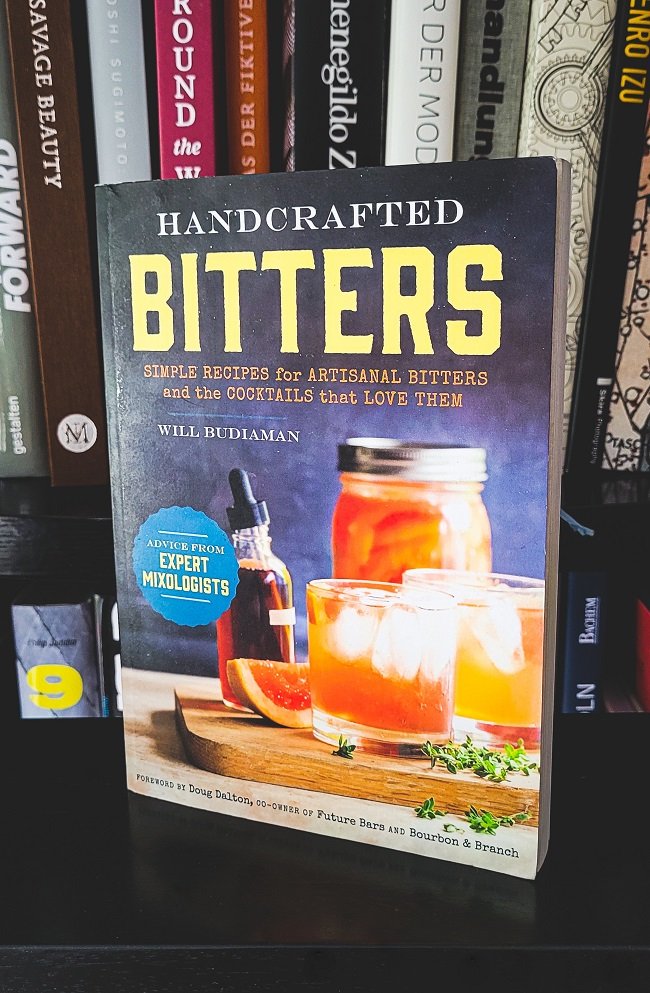Handcrafted Bitters - Will Budiaman
Handcrafted Bitters:
Simple Recipes for Artisanal Bitters and the Cocktails That Love Them
Will Budiaman / 190 Pages / July 2015
These days there are quite a few books and extensive online collections about homemade bitters. One example is this already quite early (2015) published manual, let me tell you about its content.
Will Budiaman himself is actually not a bartender at all, but that's not uncommon with cocktail books, especially recipe collections and even more so with meta-topics that overlap with other culinary topics, like bitters & tinctures. He graduated from the acclaimed International Culinary Center, is a NYC based writer and recipe developer for various companies, magazines and websites, including Bon Appétit and Epicurious (very cool Youtube channel, btw), and has been the ghost writer for 3 modern cookbooks already.
After a very short preface and introduction he starts with a short summary -maybe 8-10 pages- of the history of bitters, written to be easily understandable, but also quite minimalistic. If you want to be informed more comprehensively about bitters and their tradition, you should definitely reach for something else (aka wait for later reviews...). But this claim is not raised in the title of the book in the first place, which emphasizes more the D.I.Y. aspect. In between the different chapters at the beginning, as in many modern magazines, you will find this type of "information boxes" with a specific topic, these are for example the Old Fashioned and Sazerac as the two fundamental bitters using drinks of the two well-known brands (Ango and Peychaud's), but also two short comments of the founders from some bitters brands, like Scrappy's and Hella Bitters.
An example from the bitters recipes
Now comes the so-called "Bitters Lab", this is about the preparation and most important information. First the ingredients, where he gives quite nice descriptions of the aromas and notes for the most important 6-8 examples. Divided as usual into bittering and flavoring agents, as well as spirits (as a basis). I would have liked to see a few more of these examples, but as mentioned again later, it is limited to exactly those that are needed for the 28 recipes in the book. Which is at least quite a good number for such a small manual.
Then follows the usual list of needed utensils, but also a very nice short tip list, concerning buying and finding the ingredients. What kind of stores are there, what should you look for while selecting your ingredients, etc. Of course theoretically mostly related to the U.S. customer, but almost everything helps you here in Germany too (apart from the shops), for example.
Then we come to the preparation itself, "The Method". Here it gets interesting, the two different "schools" or procedures are explained, "Combine & Infuse", meaning as usual with simple infusions: just give everything directly into the spirit depending on the required infusion time. Everything takes place then in that one bottle and is prepared ready for use. Or the second way with tinctures, which is also used a lot in the book. Here you prepare instead with mostly only a single or very few ingredients exactly on one note focused tinctures (rhubarb tincture, orange tincture, etc.) and if you want to make bitters with it, you mix different tinctures plus water and sugar together. This way, of course, you can experiment more with ratios in small batches and not risk too much liquid and ingredients at once.
He explains an important "primer", meaning a general guidance on how tinctures will almost always work in the preparation, more tips and a nice little table for the infusion times of all (again, only for the ones needed in this book) needed ingredients in a tincture.
Only after that the real bitters recipes start (see photo 1 above), all of them separately in the different thematic cocktail chapters (see photo 2 below).
The categorization with seasons & bitters
These are divided into the four seasons with matching selected drinks, which of course all use bitters, ideally the homemade ones.
Such a categorization, to have the actual bitters recipes distributed throughout the whole book, first seems somewhat confusing to the typical cocktail book reader. One is usually accustomed to find all "additional recipes" for infusions, etc. collected before the main cocktail recipe part or after it. Here, however, it makes sense to sort them with the examples of application, the cocktails, but still it can sometimes lead to a longer search than if one had a general list at the beginning/end.
Overall from the 28 bitters recipes about 2/3 are made with the tincture method, the rest by the classic infusion of all ingredients at once. So this can sometimes really mean that simply 2-3 tinctures + water and sugar are used in the instructions.
There are always 2 drinks per bitters recipe (56 in total), almost all of them riffs on classics or other well-known recipes, such as a Blood Orange Negroni, Smoky Old Fashioned, Rhubarb Martini and so on (not all of them can be derived so easily from the name).
Per seasonal chapter there is then in between again a double page as insertion, "Take it to the next level", where basically as inspiration further herbs, fruits, spices, etc., which are typical for the season, are listed. This is simply there to show what is still possible beyond the scope of the book itself, quite nice.
At the end a few commercial bitters are briefly mentioned. The selection seems somewhat thrown together, maybe 10 selected ones are listed. Partly only certain bottlings of one brand, partly complete brand ranges, TBT is not represented at all for example.
Behind that the sources and separately a recipe index and general index.
Conclusion:
Handcrafted Bitters is a very well put together book for what it wants to be, a small manual for bitters making and as a bonus also contains examples of use in many classic recipes. You should not expect unique design, extra work (e.g. infusion times for tinctures not specifically used later in the book, more on the history of bitters, etc.) or brilliant texts. However, for those who want a book on the titular topic, this would definitely be in my top 2-3 recommendations, as intrinsically extensive in its recipes, written in an entertaining manner, and focusing on the essentials.
If you want a more beautiful design and feel, as well as a bit more history and more signature drinks, you should first reach for "Bitters" by Brad Thomas Parsons (review to follow in the near future). But it contains also only half as many Bitters recipes. In addition, very few of these overlap, so I can recommend anyone really interested in the topic to get both books to cover the whole range.




